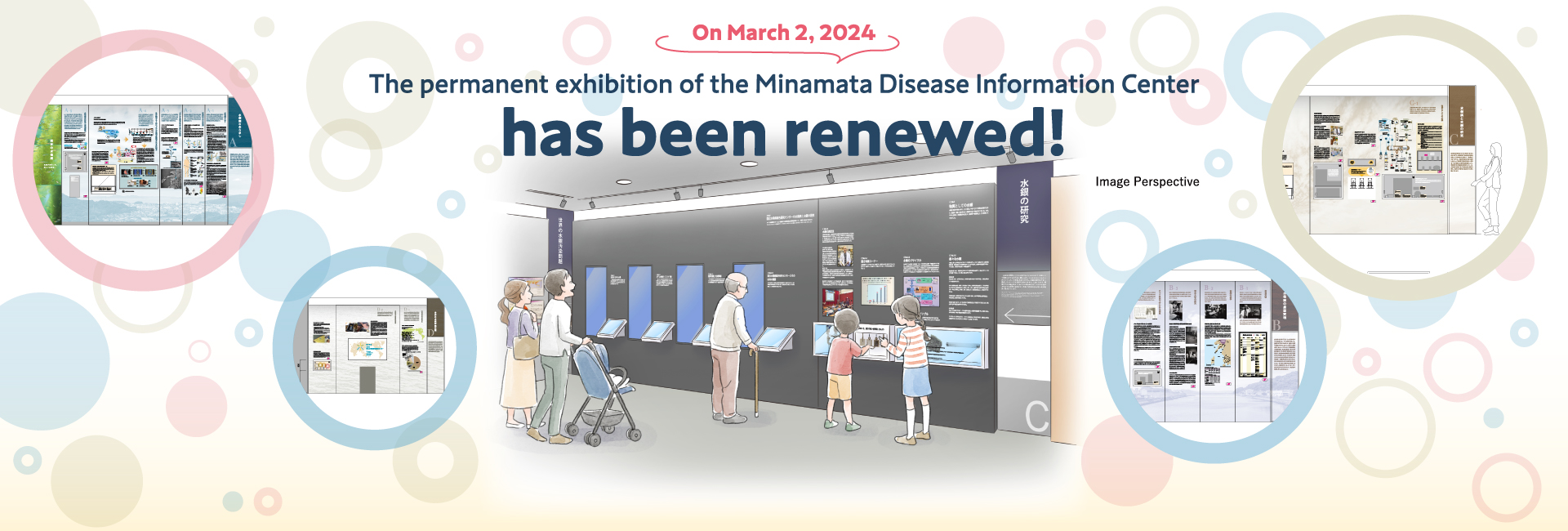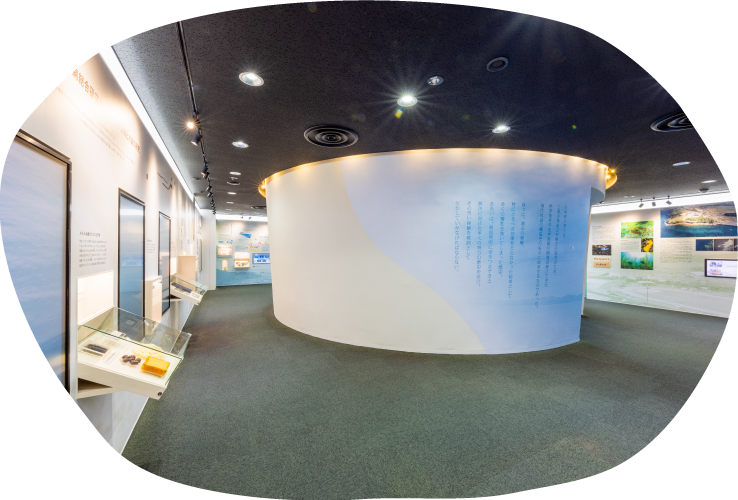
 Permanent Exhibitions
Permanent Exhibitions
In addition to learning about Minamata disease, visitors can learn facts about mercury, the substance that caused Minamata disease, including types and properties of mercury that exist in nature and the transit (circulation) of mercury. Also on display are the results of measurements, updated constantly, of the mercury concentration taken of the seawater and in the atmosphere of Minamata Bay. Other information being presented in the Archives includes findings from research conducted by the National Institute for Minamata Disease, as well as information on international cooperation activities for mercury pollution issues around the world and on the Minamata Convention on Mercury.
A sketch of Minamata disease (Exhibition A)
The exhibition illustrates the mechanism of Minamata disease onset and characteristics of symptoms, the effects of methylmercury on the brain, the process of methylmercury production, release into the sea, and accumulation in the human body, and the pollution of Minamata Bay and environmental restoration.
Exhibition items
❶ What is Minamata Disease? / ❷ The cause: methyl mercury / ❸ Generation of methyl mercury and its release to the ocean / ❹ Mechanism of how methylmercury shifts from fish/shellfish and concentrates in the human body / ❺ Pollution and environmental restoration of the Minamata Bay
Determination of the cause of Minamata disease (Exhibition B)
The exhibition illustrates the research and history of the research by researchers and doctors from Kumamoto University and various other organizations leading up to the investigation of the cause of Minamata Disease, as well as the chronology of the early research.
Exhibition items
❶ Determination of the cause / ❷ Epidemiology in the early days / ❸ Research conducted by Kumamoto University / ❹ Studies conducted internally by the Chisso Corporation
Research on Minamata Disease and mercury (Exhibition C)
Exhibits include the forms of existence of mercury as a substance, recycling, methods of measuring mercury, and research on Minamata disease and mercury by National Institute for Minamata Disease.
Exhibition items
❶ Mercury as a substance / ❷ Overview of NIMD and its research / ❸ Clinical activities and community contributions / ❹ Risks and prevention of methylmercury / ❺ Mercury in the natural world
Mercury pollution incidents around the world (Exhibition D)
The exhibition illustrates global mercury emissions, pollution from metallic and inorganic mercury emitted during small-scale gold mining and other processes, and the international contributions of the National Institute for Minamata Disease to the global mercury pollution problem.
Exhibition items
❶ Global mercury pollution / ❷ NIMD's international contribution activities
Questions and answers about Minamata disease and mercury (Exhibition E)
This is a questions and answers corner where you can use a touch panel to solve your questions about Minamata disease and mercury. Organize what you have learned in the exhibition space of the Minamata Disease Archives.
Messages from Minamata (Exhibition F)
Theis exhibition illustrates Minamata as it is today and what is being done for Minamata in the future. Join us to think about what we can do to make the most of our experience of Minamata disease.
Exhibition items
❶ Minamata as it is today / ❷ Minamata in the future
Video Corner
Four videos themed on mercury or Minamata disease are screened: Our environment and mercury; Methyl Mercury in the human body and its impact on health; Methyl mercury contained in fish/shellfish and how it gets ingested and: Ocean of Minamata
Multi-language options
Exhibitions A, B, C, D and F have multi-language options with four languages: English, Chinese, Portuguese and Spanish.
For Exhibitions A, B and C, an outline of the material being exhibited can be given in a translated language in subtitled form. For Exhibition D, videos available for replay can be subtitled in a translated language (some narrations are also translated). For Exhibition F, all exhibited materials can be viewed in a translated language.
Language selection monitor and monitors with translations Language selection monitor Outline given in a translated language


















